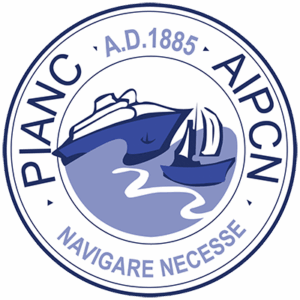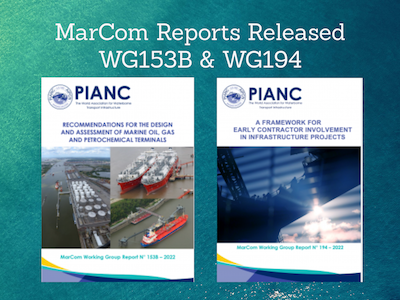In October 2022 MarCom WG153B ‘Recommendations for the Design and Assessment of Marine Oil, Gas and Petrochemical Terminals.‘ was released.
In August 2022 MarCom WG 194 ‘A Framework for Early Contractor Involvement in Infrastructure Projects’ was released.
About WG153B
In September 2016, PIANC published the document WG 153 ‘Recommendations for the Design and Assessment of Marine Oil & Petrochemical Terminals’. This document explicitly excluded LNG terminals from the scope since it was believed to add unnecessary complexity to an already-ambitious undertaking. WG153B released in October 2022 now adds LNG terminals to the scope of the document with other updates as well.
Applicability: These guidelines are applicable to at-shore and nearshore MOGPTs. Quays (wharves), jetties (piers), sea islands, and nearshore single-point and multi-point moorings are examples of the types of terminals that are covered in this document. Terminals and marine facilities for the following types of terminals are included: Oil terminals, Petrochemical terminals, Liquefied natural gas (LNG) terminals, Liquefied petroleum gas (LPG), terminals, Floating LNG terminals (FSRU/FSU/FRU/FPSO LNG), Liquefied green fuels terminals, Liquefied CO₂ terminals and Compressed natural gas (CNG) terminals.
Scope of Document: The guidelines provided in this document focus primarily on the marine terminal infrastructure. Site selection and concept selection are included in the scope of the document. The marine terminal infrastructure includes everything from the ship/shore interface to the foreshore area of the terminal.
In addition, the scope of the document includes subsea pipelines, navigation and approach channel, turning basin and manoeuvring and operational areas, which are covered primarily by reference to other established guidance documents on these topics.
Excluded from the scope of this document are the onshore facilities beyond the foreshore, such as the tank farm, onshore pipeline, pumping equipment, and process-related facilities.
For more information about WG153B please see here.
About WG194
SOME BACKGROUND ON THE REPORT
Waterborne Transport Infrastructure (WTI) projects are becoming ever more complex and subject to critical time and budgetary constraints. It is increasingly acknowledged that the potential for project cost blowouts, coupled with the progressively complex nature of planning for WTI projects, can negatively affect both the procurement and execution processes for many projects. Early Contractor Involvement (ECI) is a strategy initiated by infrastructure owners (clients) towards main contractors and optionally expanded to consultants, stakeholders and subcontractors. The purpose being to optimize values in project delivery and objectives, through their participation and knowledge sharing in stages of project planning and design prior to project execution.
This report is a detailed introduction into the understanding and the application of Early Contractor Involvement in Waterborne Transport Infrastructure projects. It illustrates that it is a practical guidance to all industry practitioners to assist in the application of ECI in the WTI sector. The report also identifies that the hallmarks of a successful ECI process have been established, such as addressing good faith, transparency, equal treatment of all parties, fairness, clarity through clear rules of engagement and protection of intellectual property. The aim of the report is to further promote and support the use of ECI in the WTI sector and provide guidance to industry practitioners in how to successfully implement ECI for the betterment of the industry as a whole.
For more information please see here.

